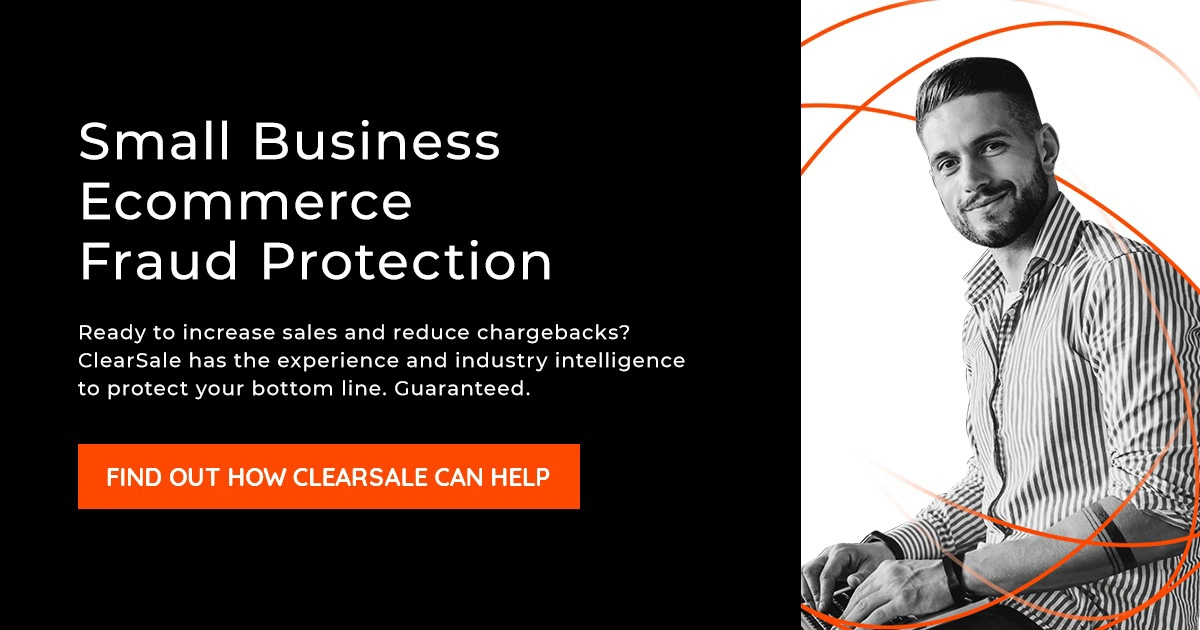There are a wide range of options out there to help you protect your small ecommerce business from the types of fraud we’ve discussed in this guide.
The question is, what will be the best option for your business? Let’s examine each in detail.
Small Business Guide to Ecommerce Fraud Protection
There are a wide range of options out there to help you protect your small ecommerce business from the types of fraud we’ve discussed in this guide.
The question is, what will be the best option for your business? Let’s examine each in detail.

When we talk to small businesses about fraud prevention, the most common response we hear is that they already have fraud filters in place.

Fraud filters are usually built into your ecommerce platform. They’re designed to identify potentially fraudulent orders and prevent them from being processed, and they function differently, depending on which one you use:

Velocity filters limit how many sales can be submitted to your website during a given time period. This prevents fraudsters with lists of stolen credit card numbers from testing all of them by flooding your site with orders.

Address verification service (AVS) is a filter that declines or flags transactions when the billing and shipping addresses don’t match. These are intended to keep credit card thieves from having merchandise delivered to another address.

Time-of-purchase filters are used to flag or block transactions during a specific timeframe – usually when fraudulent transactions are more likely to occur, such as holidays and special sales.

Card verification value (CVV) filters look for errors in the CVV number being submitted.

Purchase amount filters flag high-dollar transactions that fall outside a typical transaction amount.

IP address mismatches can flag transactions where the customer’s IP address and shipping address don’t match, a potential fraud indicator.
Fraud filters are commonly included in ecommerce platforms (the ecommerce platforms for small and medium size businesses that integrate with ClearSale all offer fraud filters.)

While fraud filters have value and can provide insight into what is happening on your ecommerce site, they can also create more problems than they solve.

For example, your best customer might be on vacation when she remembers that her friend’s birthday is coming up, so she places an order from her phone while in her hotel room. A fraud filter might identify that the geographic location of the device is different from the credit card account address and therefore decline that transaction – even though it is in fact legitimate.

While fraud filters do put ecommerce businesses at risk of increasing false declines and lowering your approval rate, they are very effective for identifying which transactions should be flagged for further analysis and manual review.
Pros:
Cons:
Selecting the right combination of fraud filters can be overwhelming. Learn more about each type of filter and how filters fit into your larger fraud prevention program: The Beginner's Guide to Fraud Filters

Secondary fraud review is just that: a team of individuals manually reviewing each transaction (or a selection of transactions) to detect fraud. This can be done in-house through a fraud review team that analyzes orders, or through an external third party, where the business sends orders that seem “iffy” to a fraud protection vendor to analyze.

Expertly trained humans are generally better at understanding context than automated fraud filters. These fraud experts can look at each situation individually to assess the fraud risk, instead of blindly adhering to preset rules.
These experts can also dig quite deep while investigating—for example, by performing reverse lookup searches on addresses and phone numbers, calling a bank to verify records, and even calling the customer to ask authentication questions.

On the other hand, manual review is very time- and resource-intensive. Even the best manual reviewer can’t work as quickly as a computer program, so customers may have to wait slightly longer to be approved for their orders. However, most small businesses who’ve worked with a fraud prevention solution will say the secondary review is worth the wait.

If you want to keep your manual review team in-house, you’ll need to hire experienced staff or pay to train them. This can be a solid approach if your volume and business are stable, but a sudden (or seasonal) increase in business could add strain. In those cases, outsourcing manual fraud review can provide better flexibility.
Manual review on its own can be costly—and not as fast as filters—but is an ideal way to evaluate potentially fraudulent transactions instead of simply declining them.
Pros:
Cons:

Outsourced automated solutions allow small ecommerce businesses to offload all of their fraud protection onto a third party. Transactions are processed through automated systems and are approved or declined based on preset parameters and filters.
This type of machine learning and artificial intelligence (AI) are fast and reliable because they use mathematical algorithms and data to identify fraud trends and patterns. And because no humans are involved in this form of fraud detection, machine learning is scalable and consistent. Every transaction receives the same level of scrutiny.
But, if you recall from Chapter 4 where we discussed false declines, making decisions about transactions purely because they appear to be fraudulent increases the risk of declining legitimate transactions. And that can have a serious negative impact on customer experience.
Without human intuition, analysis or interaction, you can’t contact a longtime client to get more information about a suspicious purchase. The last thing you want to do is have an algorithm drive away your best customers.
Outsourced automated fraud protection using machine language and AI can detect most fraudulent transactions and identify transactions that require further review.
Pros:
Cons:
Fraud managed services incorporate a two-pronged approach: Prevent fraud from happening ... and protect the small business if a fraudulent transaction does slip through.
A managed services solution does this by blending a fraud protection strategy, chargeback management strategies, and a team of trained fraud analysts.
The solution can be used in place of an internal fraud team or to augment an in-house team, especially during times of increased sales volumes or periods of rapid growth.
Here’s how it works:
Typically, as an order comes in, it is screened in real time using automated technology that may include geolocation, email validation, fraud filters, machine learning and fraud score.
However, even if the order looks like it might be fraudulent, the order is not automatically declined.
Instead, any order that fails to pass the initial screening is sent to a manual review team for analysis. There, a team of expert analysts reviews the order to see if data is missing, compares the order to that cardholder’s typical ordering or store behavior, and contacts the customer for further authentication if needed.

By combining all of the options available for fraud protection, a fraud managed solution offers ecommerce businesses a reasonably-priced way to protect themselves from fraud without risking turning away good customers. Plus, you’ll still have control over the process without having to manage every aspect of the process.
Pros:
Cons:
If you’ve settled on what type of fraud protection you want, great! But now comes the tricky part—making a decision. There are a lot of fraud prevention solutions out there. What questions should you ask to find the perfect match for your business?
[ Chapter 4 ] Understanding False Declines
[ Chapter 6 ] Important Factors to Consider